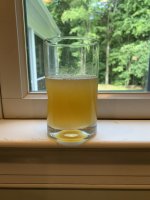This is so frustrating - I lost another batch to infection. It was a house ipa I have brewed a hundred times. Over a year ago I lost a few batches in a row to some infection, and this is the same infection. I have had at least 30 good batches since then. It got in everything back then and I ended up sanitizing or replacing everything down to the beer lines. I am not sure what the infection is. It is characterized by:
- happens in the fermenter.
- beer that won’t clear even after gelatin fining and time.
- a chemical smell to the beer. My wife calls it formaldehyde smell, but I can’t compare it to anything, other than just unpleasant chemically. A guy at my lbs said it was a phenol smell.
- harsh bitter taste. I make ipas but this is more like high hop burn bitterness. I mean its not like spit out harshness, but definitely not pleasant. I have drank a glass of it in the past, but the smell is so off-putting
- gets worse with time even if refrigerated. i left one for a month last year and it did not get better, just worse.
- it doesn’t match the smell or description of any infection I have read about.
Since last year I have upped my cleaning with pbw and Starsan for everything every time. I clean the port valves with a brush and soak in Pbw. I just don’t know how the exact same infection came back. I use adjusted RO water, brew in a ported 15 gallon Anvil kettle, cool with drop in coil chiller, transfer to a clean ported stainless bucket fermenter through a short cleaned silicon hose, and ferment in a regulated freezer. I use a cleaned rubber stopper and air lock. I gelatin fined this time but did not dry hop.
It just sucks to lose a batch and I don’t want to lose more, so what is it and what can I do.
- happens in the fermenter.
- beer that won’t clear even after gelatin fining and time.
- a chemical smell to the beer. My wife calls it formaldehyde smell, but I can’t compare it to anything, other than just unpleasant chemically. A guy at my lbs said it was a phenol smell.
- harsh bitter taste. I make ipas but this is more like high hop burn bitterness. I mean its not like spit out harshness, but definitely not pleasant. I have drank a glass of it in the past, but the smell is so off-putting
- gets worse with time even if refrigerated. i left one for a month last year and it did not get better, just worse.
- it doesn’t match the smell or description of any infection I have read about.
Since last year I have upped my cleaning with pbw and Starsan for everything every time. I clean the port valves with a brush and soak in Pbw. I just don’t know how the exact same infection came back. I use adjusted RO water, brew in a ported 15 gallon Anvil kettle, cool with drop in coil chiller, transfer to a clean ported stainless bucket fermenter through a short cleaned silicon hose, and ferment in a regulated freezer. I use a cleaned rubber stopper and air lock. I gelatin fined this time but did not dry hop.
It just sucks to lose a batch and I don’t want to lose more, so what is it and what can I do.




